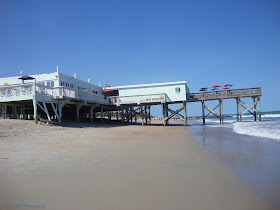 |
| August 2013 |
The building dates back to 1888 when clothiers such as Reuben's, Leon's and Bluestein's were a large part of the economy in Charleston. It is believed to have been a Leon's Men's clothing store. In 1989, Hurricane Hugo devastated Charleston. The building was damaged and remained abandoned since until it was purchased by the Charleston restaurant group. After a complete renovation of the building, the highly anticipated King Street "contemporary American" eatery opened in the Spring of 2015. Its name is its address, Four Ninety-Two. Executive Chef Nate Whiting presides over the kitchen.
 |
| December 2015 |
 The main downstairs dining area is outfitted with a long community table accompanied by red, low-backed chairs. On the left, diamond-backed booths topped with large mirrors line the wall and to the right a bar. Moving beyond the community table is a more intimate seating area with wing-backed chairs and to the right a long, wood covered bar where patrons can be seated with a view of the open kitchen. Chef Whiting said they wanted to "dissolve the borders" between the cooks and the diners. The space features an artistic piece called the "button wall" and an "eating room red" ceiling. It seats around 75 guests.
The main downstairs dining area is outfitted with a long community table accompanied by red, low-backed chairs. On the left, diamond-backed booths topped with large mirrors line the wall and to the right a bar. Moving beyond the community table is a more intimate seating area with wing-backed chairs and to the right a long, wood covered bar where patrons can be seated with a view of the open kitchen. Chef Whiting said they wanted to "dissolve the borders" between the cooks and the diners. The space features an artistic piece called the "button wall" and an "eating room red" ceiling. It seats around 75 guests.Upstairs is an event dining room and a sun-drenched rooftop garden. The upstairs hall ceiling is painted a "piazza blue"--a well-known Charleston paint color. The rooftop garden is filled with wooden planters and white, plastic pillar planters filled with seasonal herbs and vegetables that will be used in the kitchen.
The most predominate and daring feature is the addition of the large metal fence separating 492's courtyard from the busy King Street sidewalk. The jazzy abstract metal work is actually patterned after Sanborn Street Maps. It leads to the 40-person outdoor seating area filled with tall palm trees and a curious gnome--an attractive space for guests seeking to enjoy the beautiful Charleston outdoor atmosphere.
The menu is broken down into seven categories: Fields And Gardens, Pasta And Grains, From The Sea, From The Land, Dessert, Cocktails, and Local Craft Beers. It changes daily, so you will need to call for information about your chosen night's menu. A three course dinner will cost about $30 on average. Cocktails are $10 and Local Craft Beers $6.
There are two upcoming events scheduled. On Thursday, December 31st at 5-11 pm, there will be New Year's Eve Dinner featuring a special five-course dinner menu for $75. To view the menu, click on New Year's Eve Dinner. To make a reservation, you can call (843) 203-6338. On Sunday, January 17th at 6 pm, a Truffles and Hazelnuts Dinner with internationally acclaimed Chef Carlo Zarri of the Ristorante Villa San Carlo in Cortemilia, Italy is scheduled for $95. For tickets, click on Truffles and Hazelnuts Dinner.
There is a documented Charleston story linked to the address of 492, which is located at the corner of King Street and Mary. Notably, today's Four Ninety-Two restaurant overlooks the very spot where Reverend John Bailey Adger first met his future wife, Elizabeth Keith Shrewsbury. The meeting took place in 1831. Reverend J. B. Adger was in the second year of his studies at Princeton Theological Seminary. He was back in Charleston for a month of Spring Break. The event is described in his My Life and Times. It is recorded as follows:
"I was returning from a prayer-meeting with my mother (Sarah Elizabeth Ellison Adger) and sister Margaret (Milligan Adger Smythe). At the corner of Mary and King Streets my sister observed Elizabeth Keith Shrewsbury, with whom she had recently become very intimately acquainted, on the other side of King Street, engaged in the duty of tract distribution. She called to her to come over. It required some little urging to get her consent, but she came. My sister said to me, "Now you shall see blushes," and I saw them. I was introduced to her, and with me it was love at first sight."
John Bailey Adger was the son of a prominent businessman in Charleston. North and South Adger's Wharf are two short, cobblestone roads near the Charleston Battery named for the location of his father's shipping company, James Adger and Co. He encouraged the Charleston Presbytery to build the church that today serves a congregation at 93 Anson Street as St. John's Reformed Episcopal Church.

















































